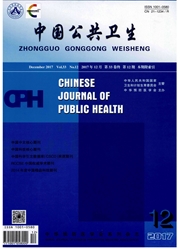

 中文摘要:
中文摘要:
目的评估中国疟疾防治系统的脆弱性,为疟疾的风险管理提供策略建议。方法采用分层随机抽样和典型抽样相结合的方法于2015年7月—2016年2月在湖北、安徽和广西3个省共抽取8个样本县(区),通过文献检索、小组头脑风暴和专家咨询等方法编制调查问卷对样本县(区)疟疾流行现状和居民的疟疾防治知识进行调查,选出代表性指标,运用TOPSIS法对样本县(区)的疟疾防治系统脆弱性进行评估。结果通过文献检索、小组头脑风暴和专家咨询,最终选取经济脆弱性、社会脆弱性、政治脆弱性、卫生系统脆弱性和敏感性5个维度共19个指标,权重系数为0.0092—0.1037,其中,疫区流人人员数量(0.1006)和政府疟疾风险关注度(0.1037)权重系数较大;中国8个样本县(区)疟疾防治系统脆弱性从高到低依次为湖北省潜江市(0.65242)、安徽省淮南田家庵区(Q57839)、安徽省肥西县(0.50958)、湖北省广水市(0.45992)、广西省都安县(0.40582)、安徽省淮南谢家集区(0.36989)、广西省天峨县(0.23474)、广西省南丹县(0.18166),总体的系统脆弱性不高。结论中国疟疾防治系统总体脆弱性不高,政府疟疾风险关注度和疫区流人人员数量是影响疟疾防治系统脆弱性最为重要的风险因素。
 英文摘要:
英文摘要:
Objective To assess the vulnerability of malaria control system in China and to provide suggestions for malaria risk management. Methods Using stratified random sampling and typical sampling, we selected 8 counties in Hubei, Anhui and Guangxi provinces for a survey between July 2015 and September 2016. Representative indicators for epidemic and control of malaria were established by using literature research, brainstorming, expert consultation, and ques-tionnaire survey. The vulnerability of malaria control system in the selected areas was evaluated with technique for order- preference by similarity to ideal solution (TOPSIS) method. Results A total of 19 indicators referring to 5 domains of the malaria control system (economic vulnerability, social vulnerability, political vulnerability, health system vulnerability and sensitivity) were identified and the weight coefficients of the indicators ranged between 0. 009 2 and 0. 103 7, with the two higher values for the weight coefficient for the number of mobile population (0. 100 6) and government attention to malaria risk (0. 103 7). The overall vulnerability of malaria control system in the surveyed areas was not at a high level and the vulnerability scores from high to low for the 8 areas were 0. 652 42 ( Qianjiang municipality of Hubei province) ,0. 578 39 (Tianjia'an district of Huainan municipality of Anhui province) ,0. 509 58 (Feixi county of Anhui province) ,0. 459 92 (Guangshui municipality of Hubei province) ,0. 40582 (Du'an county of Guangxi Zhuang Autonomous Region) ,0. 578 39 (Xiejia district of Huainan municipality of Anhui province) ,0. 234 74 (Tian'e county of Guangxi Zhuang Autonomous Region), and 0. 181 66 (Nandan county of Guangxi Zhuang Autonomous Region), respectively. Conclusion The overall vulnerability of malaria control system in China was not high and is mostly influenced by the number of mobile population in epidemic areas and the government attention to malaria risk.
 同期刊论文项目
同期刊论文项目
 同项目期刊论文
同项目期刊论文
 期刊信息
期刊信息
